Discover 20 hidden attractions, cool sights, and unusual things to do in Syria. Don't miss out on these must-see attractions: National Museum of Damascus (Damascus), Umayyad Mosque (Damascus) or Azm Palace (Damascus).
Below, you can find the list of the most amazing places you should visit in Syria.
Table of Contents
National Museum of Damascus, Damascus
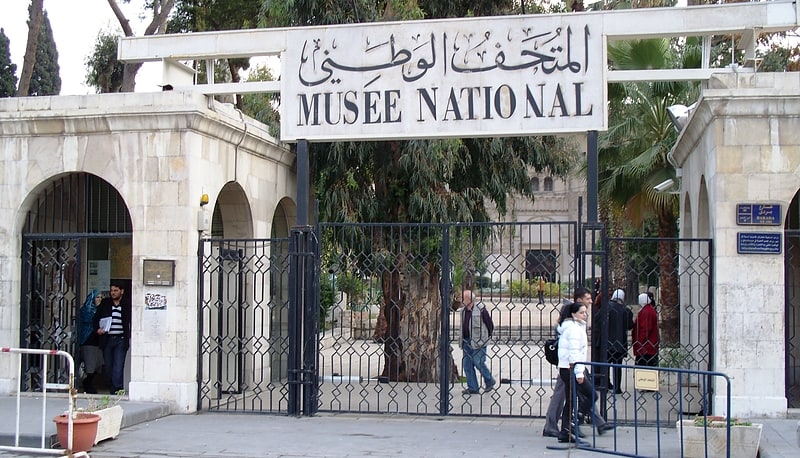
Also known as: المتحف الوطني بدمشق
Museum of Syrian history and art. The National Museum of Damascus is a museum in the heart of Damascus, Syria. As the country's national museum as well as its largest, this museum covers the entire range of Syrian history over a span of over 11 millennia. It displays various important artifacts, relics and major finds most notably from Mari, Ebla and Ugarit, three of Syria's most important ancient archaeological sites. Established in 1919, during King Faisal's Arab Kingdom of Syria, the museum is the oldest cultural heritage institution in Syria.
Among the museum's highlights are, the Dura-Europos synagogue, a reconstructed synagogue dated to 245 AD, which was moved piece by piece to Damascus in the 1930s, and is noted for its vibrant and well preserved wall paintings and frescoes, as well as sculptures and textiles from central Palmyra, and statues of the Greek goddess of victory from southern Syria. The museum houses over 5000 cuneiform tablets, among them the first known alphabet in history, written down on a clay tablet, the Ugaritic alphabet. The museum is further adorned by 2nd-century murals, elaborate tombs, and the recently restored Lion of al-Lat, which originally stood guard at the National Museum of Palmyra, but was moved to Damascus for safeguarding.
The museum temporarily closed its doors in 2012, after the Syrian Civil War engulfed Damascus and threatened its rich cultural artifacts. The museum authorities quickly unloaded more than 300,000 artifacts and hid them in secret locations to safeguard Syria's cultural heritage from destruction and looting. After six years, the museum reopened four of its five wings on October 29, 2018.[1]
Address: Shoukry Al-Qouwatly, Damascus
Umayyad Mosque, Damascus
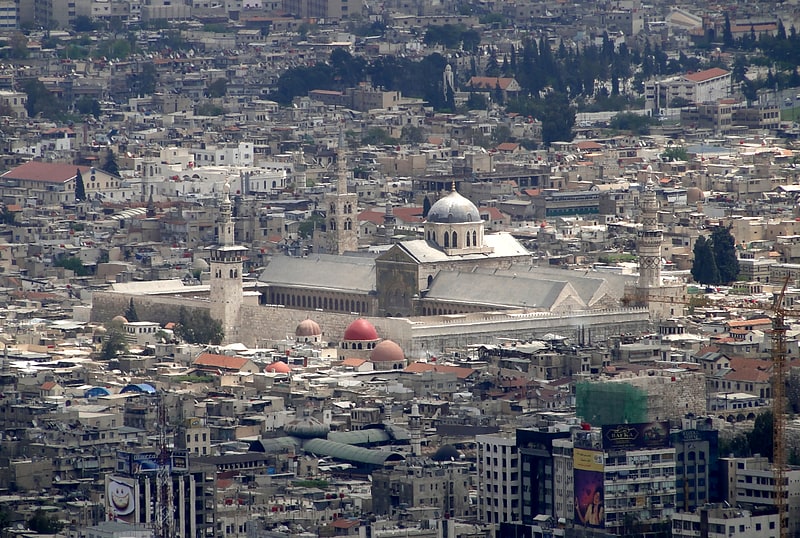
Also known as: الجامع الأموي
Landmark ancient mosque and burial site. The Umayyad Mosque, also known as the Great Mosque of Damascus, located in the old city of Damascus, is one of the largest and oldest mosques in the world. Its religious importance stems from the eschatological reports concerning the mosque, and historic events associated with it. Christian and Muslim tradition alike consider it the burial place of John the Baptist's head, a tradition originating in the 6th century. Muslim tradition holds that the mosque will be the place Jesus will return before the End of Days. Two shrines inside the premises commemorate the Islamic prophet Muhammad's grandson Husayn ibn Ali.
The site has been used as a house of worship since the Iron Age, when the Arameans built on it a temple dedicated to their god of rain, Hadad. Under Roman rule, beginning in 64 CE, it was converted into the center of the imperial cult of Jupiter, the Roman god of rain, becoming one of the largest temples in Syria. When the empire in Syria transitioned to Christian Byzantine rule, Emperor Theodosius I (r. 379–395) transformed it into a cathedral and the seat of the second-highest ranking bishop in the Patriarchate of Antioch.
After the Muslim conquest of Damascus in 634, part of the cathedral was designated as a small prayer house (musalla) for the Muslim conquerors. As the Muslim community grew, the Umayyad caliph al-Walid I (r. 705–715) confiscated the rest of the cathedral for Muslim use, returning to the Christians other properties in the city as compensation. The structure was largely demolished and a grand congregational mosque complex was built in its place. The new structure was built over nine years by thousands of laborers and artisans from across the Islamic and Byzantine empires at considerable expense and was funded by the war booty of Umayyad conquests and taxes on the Arab troops of Damascus. Unlike the simpler mosques of the time, the Umayyad Mosque had a large basilical plan with three parallel aisles and a perpendicular central nave leading from the mosque's entrance to the world's second concave mihrab (prayer niche). The mosque was noted for its rich compositions of marble paneling and its extensive gold mosaics of vegetal motifs, covering some 4,000 square metres (43,000 sq ft), likely the largest in the world.
Under Abbasid rule (750–860), new structures were added, including the Dome of the Treasury and the Minaret of the Bride, while the Mamluks (1260–1516) undertook major restoration efforts and added the Minaret of Qaytbay. The Umayyad Mosque innovated and influenced nascent Islamic architecture, with other major mosque complexes, including the Great Mosque of Cordoba in Spain and the al-Azhar Mosque of Egypt, based on its model. Although the original structure has been altered several times due to fire, war damage and repairs, it is one of the few mosques to maintain the same form and architectural features of its 8th-century construction, as well as its Umayyad character.[2]
Address: Old City, Damascus
Azm Palace, Damascus
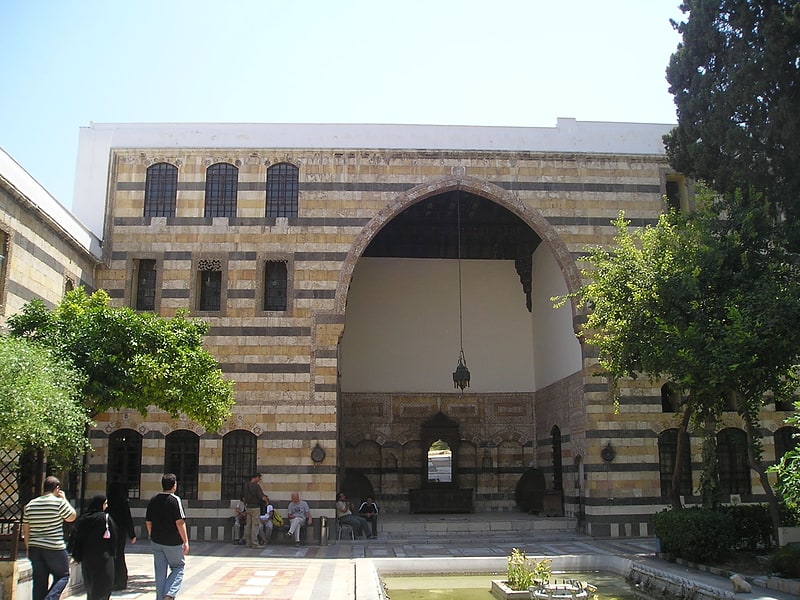
Also known as: قصر العظم
Palace in Damascus, Syria. Azm Palace is a palace in Damascus, Syria which dates back to the 18th century. Located north of Al-Buzuriyah Souq in the Ancient City of Damascus, the palace was built in 1749 and was the private residence for As'ad Pasha al-Azm, the governor of Damascus, and during the French Mandate for Syria and the Lebanon it housed the French Institute.
After being purchased by the Syrian government from the Al-Azm family and undergoing several reconstruction works, the palace now houses the Museum of Arts and Popular Traditions.[3]
Address: Damascus, Al-Buzuriyah Souq
Citadel of Aleppo, Aleppo
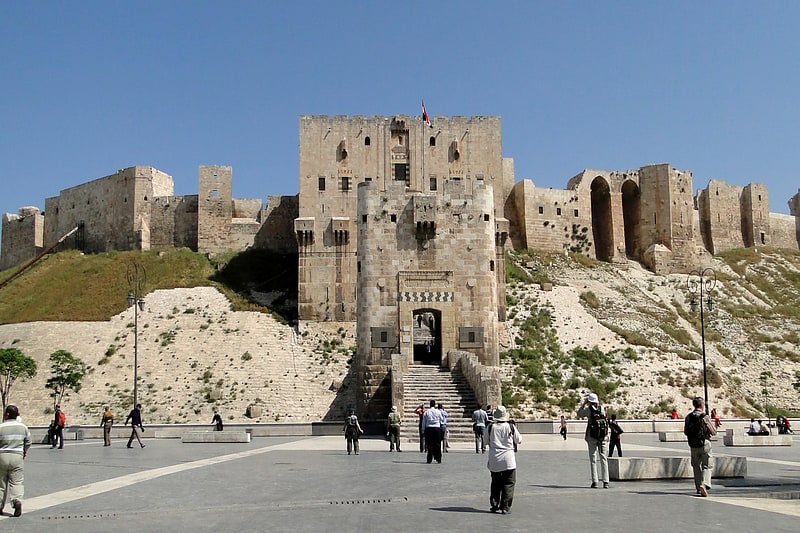
Also known as: قلعة حلب
Historical landmark in Aleppo, Syria. The Citadel of Aleppo is a large medieval fortified palace in the centre of the old city of Aleppo, northern Syria. It is considered to be one of the oldest and largest castles in the world. Usage of the Citadel hill dates back at least to the middle of the 3rd millennium BC. Occupied by many civilizations over time – including the Armenians, Greeks, Byzantines, Ayyubids, Mamluks and Ottomans – the majority of the construction as it stands today is thought to originate from the Ayyubid period. An extensive conservation work took place in the 2000s by the Aga Khan Trust for Culture, in collaboration with Aleppo Archeological Society. Dominating the city, the Citadel is part of the Ancient City of Aleppo, a UNESCO World Heritage Site since 1986. During the 2010s, the Citadel received significant damage during the lengthy Battle of Aleppo. It was reopened to the public in early 2017 with repairs to damaged parts underway.[4]
Address: Hawl Al Qalaa St, Aleppo
Great Mosque of Aleppo, Aleppo
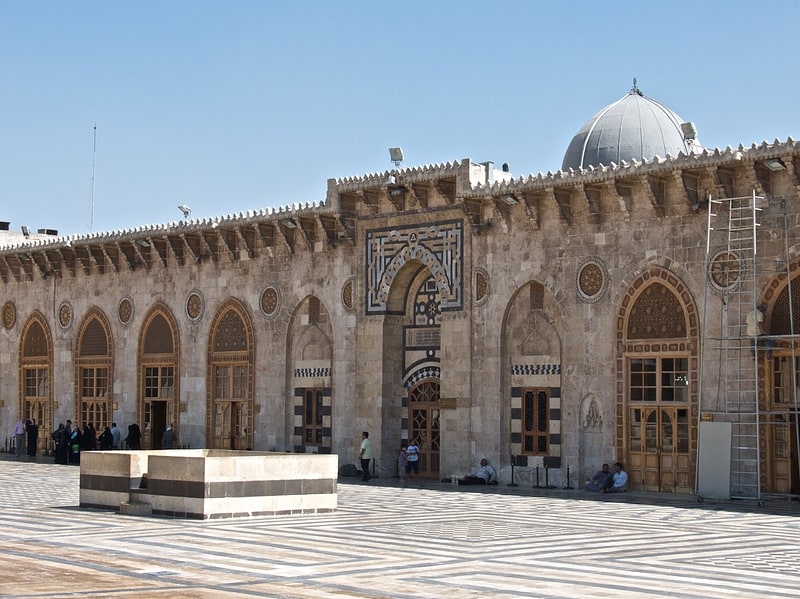
Also known as: جامع حلب الكبير
8th-century mosque with a courtyard. The Great Mosque of Aleppo is the largest and one of the oldest mosques in the city of Aleppo, Syria. It is located in al-Jalloum district of the Ancient City of Aleppo, a World Heritage Site, near the entrance to Al-Madina Souq. The mosque is purportedly home to the remains of Zechariah, the father of John the Baptist, both of whom are revered in Islam and Christianity. It was built in the beginning of the 8th century CE. However, the current building dates back to the 11th through 14th centuries. The minaret in the mosque was built in 1090, and was destroyed during fighting in the Syrian Civil War in April 2013.[5]
Address: Hawl Al Qalaa St, Aleppo
Roman Theatre at Palmyra, Palmyra
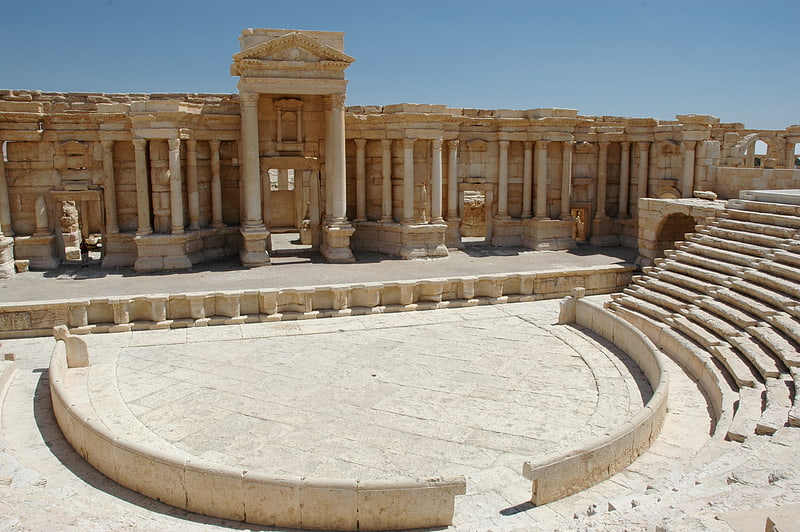
Also known as: مسرح تدمر
Performing arts theater in Tadmur, Syria. The Roman Theatre at Palmyra is a Roman theatre in ancient Palmyra in the Syrian Desert. The unfinished theatre dates back to the second-century CE Severan period. The theatre's remains have since been restored. It was occupied by the Islamic State of Iraq and the Levant in May 2015 and recaptured by the government forces in March 2016 with the support of Russian airstrikes.[6]
National Museum of Aleppo, Aleppo
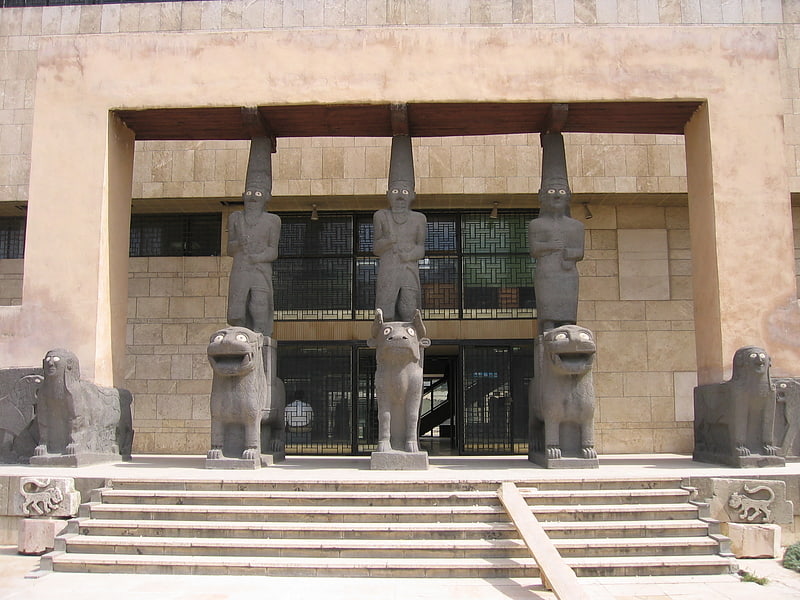
Also known as: متحف حلب الوطني
Museum of region's archaeological finds. The National Museum of Aleppo is the largest museum in the city of Aleppo, Syria, and was founded in 1931. It is located in the heart of the northern city on Baron Street, adjacent to the famous Baron Hotel and near the Bab al-Faraj Square and Clock Tower. The majority of the museum's exhibitions are devoted to the archaeology of Syria, with most of the finds coming from archaeological sites of the northern part of the country.[7]
Valley of the Tombs, Palmyra

The Valley of the Tombs is a necropolis at the west of Palmyra, Syria. It is one of the three necropoleis present around the ancient city. It is one kilometre long, and easily recognizable by its tower-tombs, among which the former towers of Atenatan, Kitot, Iamblichus and Elahbel where the earliest finds of silk were made and that were destroyed by ISIS in 2015.[8]
Palmyra Castle, Palmyra
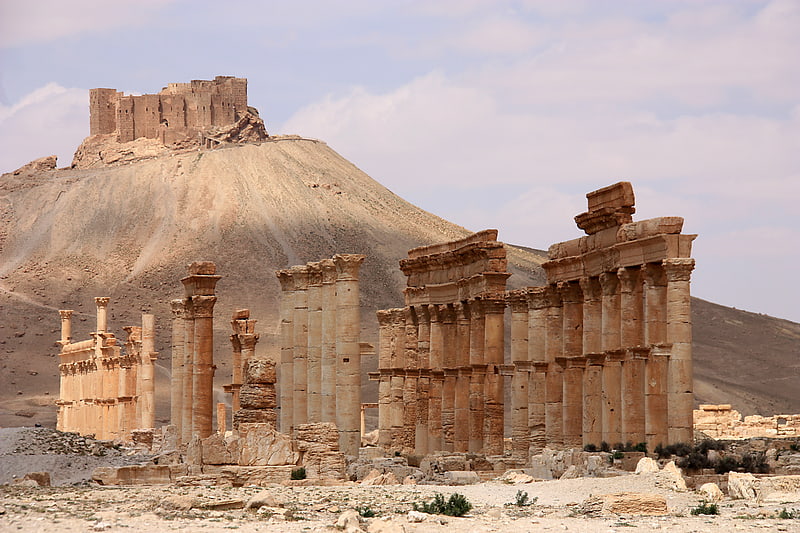
Also known as: قلعة فخر الدين المعني
Tourist attraction in Tadmur, Syria. Palmyra Castle, also known as Fakhr-al-Din al-Ma'ani Castle or Tadmur Castle, is a castle overlooking Palmyra in the province of Homs, Syria.
The castle is thought to have been built by the Mamluks in the 13th century on a high hill overlooking the historic site of Palmyra, and is named for the Druze emir Fakhr-al-Din II, who extended the Druze domains to the region of Palmyra during the 16th century.
The site of the castle and Palmyra in 1980 became a UNESCO World Heritage Site in recognition of the monumental ruins of a great city, which was one of the most important cultural centres of the ancient world. The site was designated a national monument in Syria and a buffer zone was established in 2007.
The castle lying on raised bedrock was a well defended position for a fortification with thick and high walls, which was also surrounded by a moat that had only one access available through a drawbridge.
The historic site was placed on the list of World Heritage Sites in Danger in 2013 due to the ongoing Syrian Civil War.
The castle was captured by the Islamic State of Iraq and the Levant during the Palmyra offensive in May 2015. It was recaptured by Syrian government forces in another offensive in March 2016. Retreating ISIS fighters blew up parts of the castle, including the stairway leading to the entrance, causing extensive damage. The basic structure is still intact, and Syrian director of antiquities Maamoun Abdelkarim stated that the damage is repairable and the castle is to be restored. The castle was captured by ISIL once again in December 2016. However, the Syrian Army captured it again after an assault on 1 March 2017.[9]
Azm Palace, Hama
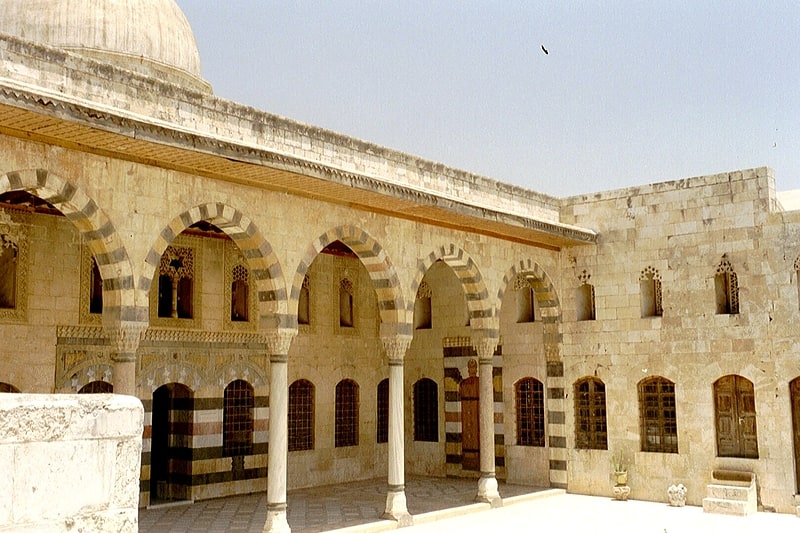
Also known as: قصر العظم
Palace in Hama, Syria. The Azm Palace is an 18th-century Ottoman-era palace in Hama, Syria at the center of the city on the banks of the Orontes River, about 400 meters south of the Hama Citadel. Ross Burns, author of Monuments of Syria, reportedly considers the Azm Palace to be "one of the loveliest Ottoman residential buildings in Syria." The palace has been used as a regional archaeology museum since 1956.[10]
Address: Hama, south of the Hama Citadel
Norias of Hama, Hama
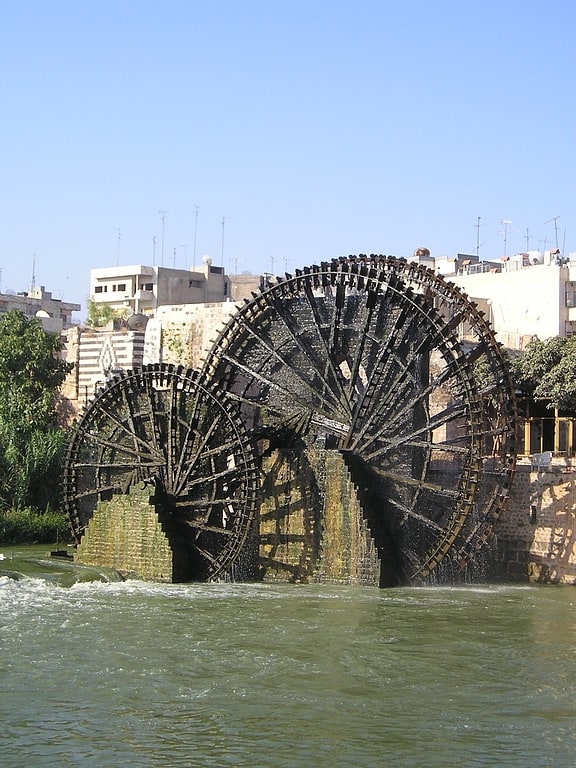
Also known as: نواعير حماة
The Norias of Hama are a series of 17 norias, historic water-raising machines for irrigation, along the Orontes River in the city of Hama, Syria. They are tall water wheels with box-like water collection compartments embedded around their rims. As the river flows, it pushes these water collection boxes under water, where they quickly fill up, then are driven up to the top of the wheel where they empty into an aqueduct. The aqueduct can carry the water to supply buildings, gardens and farmland.
Seventeen of Hama’s original norias have been conserved. They are notable for their medieval origins, for their large number and for the enormous size of two of them - for nearly 500 years the tallest waterwheels in the world. In the 21st century Hama’s norias no longer provide a water supply but are celebrated as an example of advanced water supply technology in medieval Muslim societies and for the striking sights and sounds which they make as they turn. In 2006 the older of the two gigantic norias, the Noria al-Muhammadiya, was accorded Historic Mechanical Engineering Landmark designation by the American Society of Mechanical Engineers as marking a major step forward in technology internationally.[11]
National Museum of Latakia, Latakia

The National Museum of Latakia, also known as the Latakia Museum, is a museum located in the coastal city of Latakia, Syria, near the city's seafront, facing the Port of Latakia. It was inaugurated in 1986.[12]
Khalid ibn al-Walid Mosque, Homs
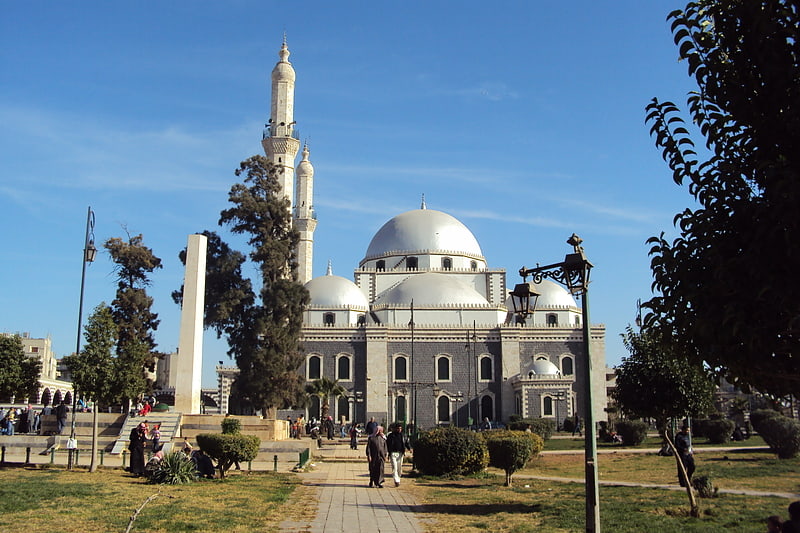
Also known as: جامع خالد بن الوليد
Landmark Ottoman design mosque. The Khalid ibn al-Walid Mosque is a mosque in Homs, Syria, located in a park along Hama Street in ash-Shuhada Square. The mosque is dedicated to Khalid ibn al-Walid, an Arab military commander who led the Muslim conquest of Syria in the 7th century following the decisive Battle of Yarmouk, which put an end to Byzantine rule in Syria. His dome-topped mausoleum is located in a corner of the prayer hall and has served as a pilgrimage center. Two tall minarets with narrow galleries constructed of alternating horizontal rows of white and black stone are situated at the building's northwestern and northeastern comers and reflect the traditional Islamic architecture style of the Levant.[13]
Address: Hama Street, Homs
Ugarit, Latakia

Also known as: أوغاريت
City. Ugarit was an ancient port city in northern Syria, in the outskirts of modern Latakia, discovered by accident in 1928 together with the Ugaritic texts. Its ruins are often called Ras Shamra after the headland where they lie.
Ugarit had close connections to the Hittite Empire, the Mitanni Empire and sent tribute to Egypt at times, and maintained trade and diplomatic connections with Cyprus (then called Alashiya), documented in the archives recovered from the site and corroborated by Mycenaean and Cypriot pottery found there. The polity was at its height from c. 1450 BC until its destruction in c. 1200 BC; this destruction was possibly caused by the mysterious Sea Peoples or internal struggle. The kingdom would be one of the many dismantled during the Bronze Age Collapse.[14]
Saint Mary Church of the Holy Belt, Homs
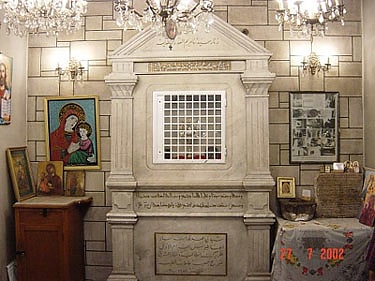
Also known as: كنيسة أم الزنار
Cathedral in Homs, Syria. Saint Mary of the Holy Belt Cathedral is a historical Syriac Orthodox cathedral in Homs, Syria. It is the seat of the Syriac Orthodox Archbishop of Homs and Hama.
The present structure dates from the mid-nineteenth century, but the site over which the church is built is claimed to have been one of Christian worship since 59 AD. According to Ross Burns, the church may rest on Byzantine foundations. According to Joseph Nasrallah, the existence of a church dedicated to Mary in Homs is attested as early as 478.
The church contains a venerated Holy Girdle that is supposed to be a section of the belt of Mary, mother of Jesus. The church was damaged during confrontations between the armed opposition and the security forces in the 2011–2012 Syrian unrest.
In 2012, reportedly confrontations caused extensive damage to the exterior of the church. The church was rebuilt by an extensive effort of the faithful and the Divine Liturgy was celebrated.[15]
Wadi al-Nasara, Krak des Chevaliers
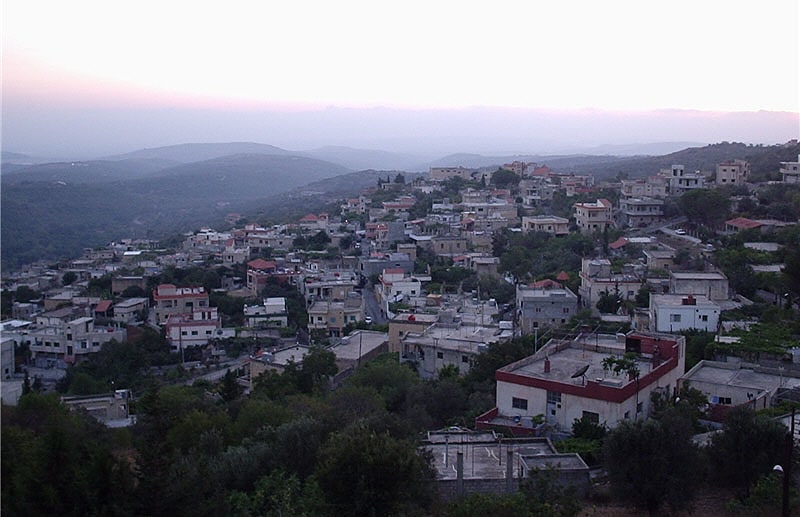
Also known as: وادي النصارى
Wadi al-Nasara is an area in western Syria, close to the Lebanese border and administratively belonging to the governorate of Homs.
Most people in the area are Greek Orthodox Christians. A large part of the valley's population comes originally from Lebanon's northern Christian villages. Their migration to the nearby valley in Syria began in the mid-19th century as a result of the Mount Lebanon Civil War.
The area of Wadi-Al Nasara is ecclesiastically under the Archdiocese of Akkar, which has its seat in Cheikh Taba, Lebanon. The current Greek-Orthodox Metropolitan of Akkar and Wadi al-Nasara and its dependencies (Safita and Tartus) is Mgr Basilius Mansour.[16]
Hama Castle, Hama
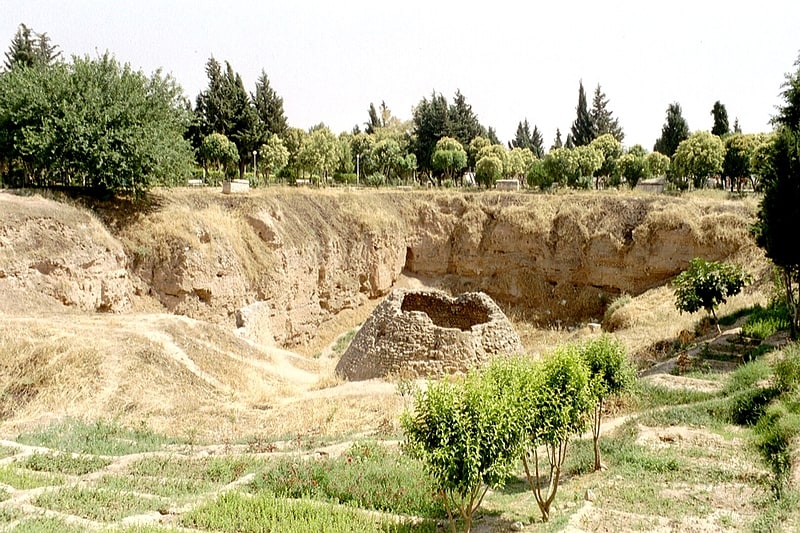
Also known as: قلعة حماة
Castle in Hama, Syria. Hama Castle is located in Hama, Syria, Located on the Orontes River.[17]
Saint George's Monastery, Krak des Chevaliers
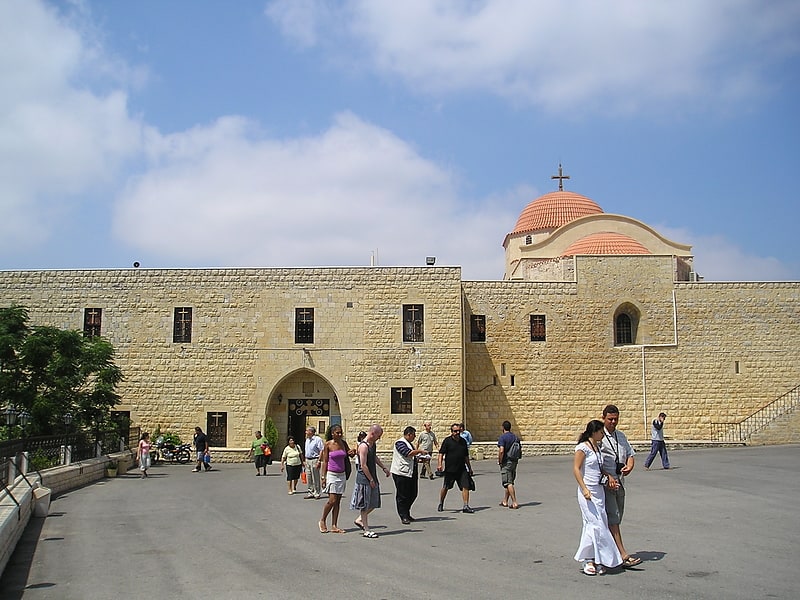
Also known as: دير مارجرجس
Monastery in al-Mishtaya, Syria. Saint George Monastery or Deir Mar Georges is a historic Greek Orthodox monastery in the village of al-Mishtaya in the "Valley of the Christians", belonging to the Homs Governorate in northwestern Syria, the place located just a few kilometers north of the famous castle Krak des Chevaliers.
Demographically, the valley is a regional center of Christianity since the 6th century. Of its 32 villages, 27 are Christian (mainly Greek Orthodox), four are mainly populated by Alawite Muslims and one, al-Husn, which is adjacent to the Krak des Chevaliers, is mainly Sunni Islamic.[18]
Citadel of Homs, Homs

Also known as: قلعة حمص
Tourist attraction in Homs, Syria. The Citadel of Homs, also known as Homs Castle or Qalaat Homs, is a historic building now mostly ruined in Homs, Syria. The citadel was built on top of an ancient tell southwest of the Old City, with remains dating back to the 3rd millennium BCE. The citadel is locally known as the "Citadel of Usama", named after Usama ibn Munqidh.[19]
Krak des Chevaliers, Krak des Chevaliers
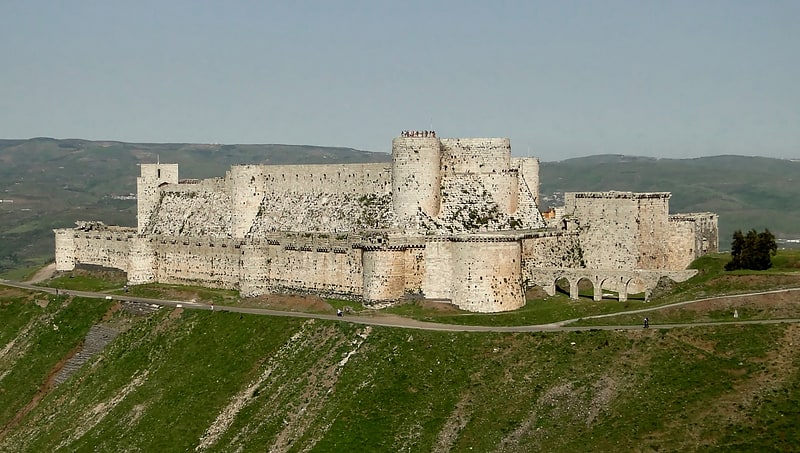
Also known as: قلعة الحصن
Castle in Al-Husn, Syria. Krak des Chevaliers or Crac des Chevaliers, also called Hisn al-Akrad and formerly Crac de l'Ospital, is a Crusader castle in Syria and one of the most important preserved medieval castles in the world. The site was first inhabited in the 11th century by Kurdish troops garrisoned there by the Mirdasids. In 1142 it was given by Raymond II, Count of Tripoli, to the order of the Knights Hospitaller. It remained in their possession until it fell in 1271.
The Hospitallers began rebuilding the castle in the 1140s and were finished by 1170 when an earthquake damaged the castle. The order controlled a number of castles along the border of the County of Tripoli, a state founded after the First Crusade. Krak des Chevaliers was among the most important, and acted as a center of administration as well as a military base. After a second phase of building was undertaken in the 13th century, Krak des Chevaliers became a concentric castle. This phase created the outer wall and gave the castle its current appearance. The first half of the century has been described as Krak des Chevaliers' "golden age". At its peak, Krak des Chevaliers housed a garrison of around 2,000. Such a large garrison allowed the Hospitallers to exact tribute from a wide area. From the 1250s the fortunes of the Knights Hospitaller took a turn for the worse and in 1271 Mamluk Sultan Baibars captured Krak des Chevaliers after a siege lasting 36 days, supposedly by way of a forged letter purportedly from the Hospitallers' Grand Master that caused the Knights to surrender.
Renewed interest in Crusader castles in the 19th century led to the investigation of Krak des Chevaliers, and architectural plans were drawn up. In the late 19th or early 20th century a settlement had been created within the castle, causing damage to its fabric. The 500 inhabitants were moved in 1933 and the castle was given over to the French Alawite State, which carried out a program of clearing and restoration. When Syria declared independence in 1946, it assumed control.
Today, a village called al-Husn exists around the castle and has a population of nearly 9,000. Krak des Chevaliers is approximately 40 kilometres (25 mi) west of the city of Homs, close to the border of Lebanon, and is administratively part of the Homs Governorate. Since 2006, the castles of Krak des Chevaliers and Qal'at Salah El-Din have been recognised by UNESCO as World Heritage Sites. It was partially damaged in the Syrian civil war from shelling and recaptured by the Syrian government forces in 2014. Since then, reconstruction and conservation work on the site had begun. Reports by UNESCO and the Syrian government on the state of the site are produced yearly.[20]